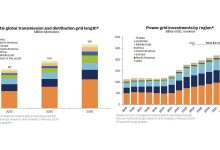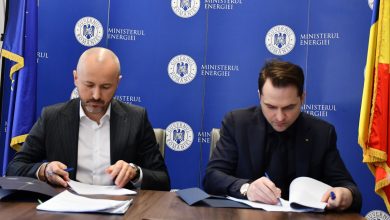ANRE Report: Barriers to Grid Connection of New Renewable Energy Capacity
The lack of legislative levers to prevent the development of potentially speculative investments, as well as the lack of a related legislative framework to prevent the lengthy grid connection process, are among the barriers identified by the National Regulatory Authority for Energy (ANRE) and the Competition Council to the successful grid connection of new renewable electricity generation capacity.
The study concludes that financing barriers still persist at the level of producers and grid operators in terms of carrying out grid reinforcement work to take up the electricity produced by the new units to be installed.
There are uncertainties at the level of electricity distribution system operators regarding the interpretation and application of the provisions of the regulatory framework in force. Last but not least, the long time required to approve projects, the non-existence of cadastral plans, the late issuance of government decisions and ministerial orders, as well as the long execution time for capacity construction works, are other barriers identified by ANRE and the Competition Council that prevent or hinder connection to the National Energy System (SEN).
Regulation (EU) 2022/2577 of 22 December 2022 sets the framework for accelerating the deployment of renewable electricity.
Valid for a period of 18 months from entry into force, with the possibility of extension, the Regulation introduces a series of measures to significantly reduce the EU’s dependence on fossil fuels from Russia and to combat the climate crisis by accelerating the transition to renewable energy sources.
To achieve this objective, the Regulation requires Member States to ensure that the permitting process for renewable electricity projects be completed within certain deadlines: 3 months for the permitting process for the installation of solar energy equipment and co-located energy storage assets and 6 months for the permitting process for retrofit projects, including all relevant environmental assessments. If the retrofit results in an increase of up to 15% of the power plant capacity, grid connection will be allowed within 3 months.
In Romania, however, these deadlines are not respected, and there are many reasons for this, as shown by ANRE’s analysis.
Objectives
Through the Integrated National Energy and Climate Plan (NECP), Romania is committed to achieving a total of 30.7% of energy from renewable energy sources in the final energy consumption mix by 2030 (Romania’s EU decarbonisation target), by increasing the installed capacity of wind and photovoltaic power plants and by increasing the number of prosumers.
To this end, by 2030 Romania must have installed capacities of 5.1 GW in solar technology and 5.3 GW in wind technology.
Romania aims to install an additional 6.9 GW of renewable capacity between 2021-2030. According to a study carried out by Romania Wind Energy Association (RWEA) in 2022, the additional variable renewable energy generation capacities to be installed by Romania between 2021-2030 are as follows:
- Wind:
- +822 MW additional installed capacity in 2022 (compared to 2020)
- +559 MW additional installed capacity in 2025 (compared to 2022)
- +556 MW additional installed capacity in 2027 (compared to 2025)
- +365 MW additional installed capacity in 2030 (compared to 2027)
- Solar:
- +994 MW additional installed capacity in 2022 (compared to 2020)
- +1037 MW additional installed capacity in 2025 (compared to 2022)
- +528 MW additional installed capacity in 2027 (compared to 2025)
- +1133 MW additional installed capacity in 2030 (compared to 2027)
Only 60% of the potential harnessed
The technical potential from wind energy sources in Romania has been estimated at around 10.23 TWh/year, currently only 60% being harnessed, as the National Energy System cannot take over unpredictable discontinuous production sources. Thus, any possible development of wind capacity must be carried out in parallel with other developments to ensure balancing services in the system. As for solar electricity, the distribution across the country is relatively uniform, with values ranging from 1,100 to 1,450 kWh/sqm/year.
Unlocking the potential of solar power for electricity generation using photovoltaic panels allows the installation of a total capacity of 4,000 MWp and the production of 4.8 TWh of energy per year.
Transelectrica, the transmission system operator (TSO), also stated that the large differences in the time taken to process connection applications are due to the time taken by users to complete the documentation attached to the connection application, which varies from a few days to a maximum of 6 months, due to the long-time taken to draw up, complete and correct the solution studies, and the time taken by users to opt for one of the connection solutions endorsed by the operators.
Regarding the time taken to resolve applications, the TSO found that it is significantly influenced by the level of training and involvement of the consultants/designers chosen by applicants.
“Thus, for the period 2019-2022, the average time taken to process connection applications submitted to the TSO was around 9 months, these durations varying between 5 and 13 months. According to the TSO, the very high volume of connection applications has led to a situation where, in order to ensure the technical conditions for the power output of the power plants, development works on the power grids are necessary, which require long lead times and may influence the commissioning time of the power generation capacities, depending on the area where the power plant is located,” the study states.
Producers’ associations, against speculators
In order to eliminate or reduce the potential speculative nature of obtaining Technical Approvals for Connection (ATRs) for new generation facilities, the producers’ associations have proposed the introduction of the obligation to pay a guarantee in the amount of 10% of the value of the connection tariff, set up within a maximum of 3 months from the issuance of the ATR, under penalty of expiry of the validity of the ATR, by amending the Regulation on the connection of users to the public interest power grids, approved by ANRE President Order no. 59/2013, as amended and supplemented.
In this respect, the producers’ associations have proposed that, in the event of signing the connection contract, the guarantee could be made as an advance for the work to be carried out on the connection tariff. If the connection work is no longer carried out, the guarantee will be returned to the beneficiary when the connection contract is terminated.
The above-mentioned proposals of producers’ associations on the guarantee concern capacities with an installed capacity of more than 10 MW, with the possibility to be returned upon expiry of the ATR.
Digitization, only in political speeches
The lack of a centralised information system for renewable energy project developers is one of the main problems identified by the stakeholders consulted for the ‘RES Simplify’ study commissioned by the European Commission and cited in the analysis carried out by the Competition Council and ANRE.
According to them, although in recent years certain online platforms have been opened for the submission of applications and supporting documents required at various stages of authorisation, interaction with authorities such as ANRE or the Environmental Fund Administration has not yet been digitised.
The lack of transparency and communication also affects the possibility for developers of renewable electricity generation projects to lodge referrals and complaints about the administrative procedure for issuing various types of permits and certifications.
This is also one of the main reasons why the legal deadlines for dealing with referrals and complaints are not respected by the authorities. In addition, due to lack of transparency, in practice only directly involved parties with knowledge of the capacity project plan can file valid complaints.
Repetitive licensing procedures
On the other hand, in Romania there are numerous institutions involved in the authorisation process of renewable energy projects, which leads to repetitive licensing procedures that unnecessarily prolong the whole process and discourage potential investors. A barrier to obtaining ATR is also the lack of staff experience with renewable energy projects.
The ‘RES Simplify’ report proposes some measures to simplify administrative procedures, such as:
- Facilitating the simultaneous completion of the various stages of the permitting procedure
- Setting up national contact points
- Simple notification procedure
- Standardisation of project acceptance criteria
- Measures to streamline/simplify the procedure for lodging referrals and complaints from third parties
- Providing advice prior to the commencement of proceedings (which is currently done informally, as the institutions involved have no legal obligation to do so).
Improvement of performance indicators
In addition, various performance indicators need to be measured, monitored, and improved.
One such indicator is the average response time of the authorities involved in the permitting and/or connection procedure. Thus, the duration of the whole process varies greatly at project level due to the lack of a uniform permitting process.
Other relevant performance indicators are rate of project approvals, rate of authorisations/permits challenged in court, rate of litigation rejected in court.
It is also recommended to create a centralised mechanism for consulting third parties with various interests in renewable electricity projects.
In practice, authorities and developers are obliged to take into account only specific interests, such as environmental protection, security or strategic issues, the authors of the study added.







